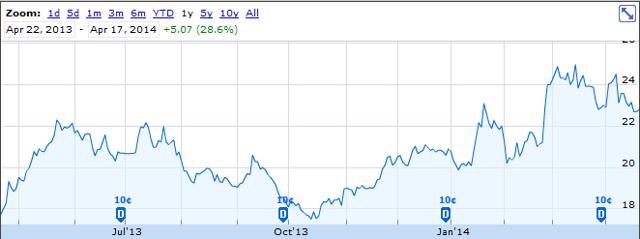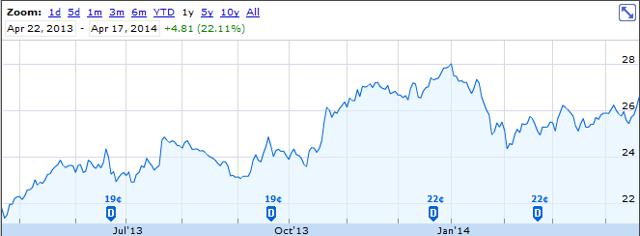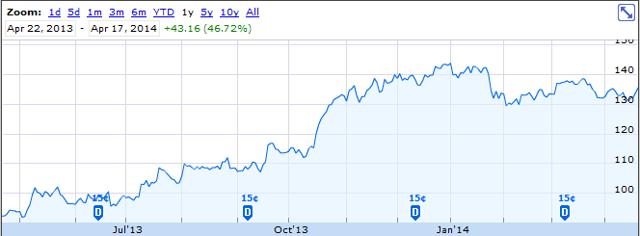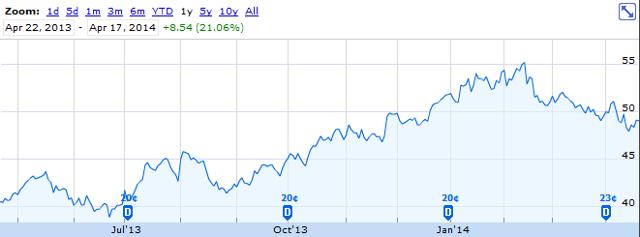Opening Remarks:
The four themes I believe to be most relevant, with regard to determining trends in the volatile capital markets we've seen YTD in 2014, are as follows:
1) Liquidity
Does the company have cash on the balance sheet, or free cash from operations, to finance operations and service existing debt, as opposed to simply rolling it over, that it can expect to not only maintain, but strengthen, over the intermediate term of five to ten years? As interest rates follow the forward guidance "gifted" to the market in "hard" to interpret dot plots, delimited only by the "stickiness of information" and other Central Banks' own stimulus packages (more buyers in effect increases competition at lower levels of yield), corporations can expect the cost of refinancing, or rolling over maturing debt into "new debt," rather than repaying the principal owed, to rise markedly from current levels, thus increasing the risk of a default-event. Investor's should consider the Altman Z-Score, amongst other due diligence considerations, in determining the viability of intermediate to long-term solvency on a company-by-company basis.
2) Currency (& Carry Trades)
The strength of the Japenese Yen, and conversely its weakness, seems to have linked to the performance of US equity markets in the first few months of 2014. My hypothesis is that this is a reflection of the volatility / devaluation in emerging markets, which might previously have served as a basis for triangular arbitrage or rather simply a carry trade. The identifiable correlation has seemingly been that as the yen weakens against the dollar, US markets have risen: I believe that this is associable to the margin-purchasing power of leveraged US institutional investors. It is also important to note that this year has proven that trends are "trending" toward being acute AND prone to causing over-adjustments, suggesting that investors are highly-interested in a justifiable investing strategy or basis.
3) Mean Reversion
Sometimes the market is prone to irrational exuberance - Dr. Robert Schiller believed in the concept so much as to write a thorough novel filled with [sometimes patronizing] proof of its existence and, more importantly, influence. Sometimes we, as human beings first and investors second (is that not the course life inevitably follows?), are swept up in the moment: it is certainly difficult to let go the anxiety of missing out at a shot of joining the winning team, especially while success [i.e. profit] might remain. The only advice I've found helpful in coaching my own over-reactions is simple in concept and yet increasingly difficult in action: patience. Have your convictions, and stick by them: if the fear of buying after an over-adjustment still bothers you, I'd recommend a previous instablog I put together to coach my own thoughts on the subject.
4) Disruptive Technology
Most of today's innovation comes in the form of incremental additions to existing technology, reflecting the accepted form of product life cycle by today's consumers; however, every so often "the next big thing" finally arrives. My argument is not that "the next big thing" could be here, but rather that as investors we should come to expect it, and thus be prepared for its contingency. Venture capital exists for a reason, arguably to promote this very event and these very inventors. Marketing professionals will be the first to tell you that nothing in the global capital markets is capable of change in the way and at the rate at which social preference may drift from seemingly-established trends.
Utilizing these four factors:
Under the guiding premise of the themes above, I've provided two strong buys, a cause for caution, and one potential sell. Focusing first on liquidity and currency trends, integral determinants of interest rate benchmarks, the need for or cost of refinancing, and, for multi-national corporations, a [sometimes] leading indicator of global sales revenue, leads me to recommend General Electric (GE) and Cameco Corporation (CCJ); turning to "mean reversion" and "disruptive technology," my strategy found reason to sell Fedex (FDX) and Comcast (CMCSA), on the basis of both weak analyst recommendations and the risk of their mature industries rolling over into its declining stage.
Cameco - [Buy]
Industry: Metals & Mining
Sector: Materials
Market Cap: $9.02 Billion
52-week Range: $17.27-25.84
Next Earnings Release - 4/29/14
Business Description: "Cameco Corporation explores for, develops, mines, refines, converts, and fabricates uranium for sale as fuel for generating electricity in nuclear power reactors in Canada and other countries. The Company also operates the Bruce B nuclear reactors in Ontario, as well as through a subsidiary, explores for, develops, mines, and sells gold." (Source: Bloomberg)
Contingent Drivers of Upside (premium):
- Private Equity interest in Canadian energy assets provides the opportunity for a providential exit multiple
- Long-term trend reversion provides the opportunity for upside / asymmetrically lower risk of further downside
- UN global warming / environmentalists' increasing influence driving an increased focus on the need for renewables and more climate-friendly energy sources, of which nuclear energy is considered a lesser evil if not a suitable alternative to carbon-based sources.
Contingent Drivers of Downside (discount):
- Nuclear wind-down (i.e. in Germany) and the push toward solar/wind-energy providers - regardless of a reduction in subsidies for clean energy producers - has the potential to reduce revenues below debt-servicing capabilities and toward the bankruptcy barrier.
- As interest rates are expected to rise over the next few years, there could be a capital outflow or rotation out of high-yield dividend stocks, like utilities, and into growth markets. This will be contingent on whether or not the market adopts a risk-on or risk-off approach, in general, with regard to the market in the interim.
- Rising interest rates increase the cost of refinancing or rolling over debt - when you put that against the uranium/nuclear energy industry-wide weak performance over the last three years, it implies an increased risk of default or threat to shareholder return (in the form of decreased dividend-paying power).
Price Target YE 2014: $26
Dominance Hypothesis [reason to keep]: Global climate concerns will necessitate the continued interim production of nuclear energy, while the world continues to search for a suitable, clean alternative. Change will not be swift or easy, and most likely be an extended effort over the next twenty years: my hypothesis is that this will provide an opportunity for intermediate-term return as [looming] disruptive technologies provide evidence that further CapEx needs in the present will be severely limited, ipso facto providing more free cash flow for shareholders.
Historical Price Chart:
Source: Google Finance
GE - [Strong Buy]
Industry: Electrical Equipment
Sector: Industrials
Market Cap: $266.46 Billion
52-week Range: $21.11 - 28.09
Next Earnings Release - 7/18/14
Business Description: "General Electric Company is a globally diversified technology and financial services company. The Company's products and services include aircraft engines, power generation, water processing, and household appliances to medical imaging, business and consumer financing and industrial products." (Source: Bloomberg)
Contingent Drivers of Upside (premium):
- Storied name and systematically important - between billions of dollars existing-order backlog, inventory, and cash yet to be repatriated/recognized, I wouldn't expect the company to disappear anytime soon.
- Safe-haven / industrial blue chip - investors, non- and institutional alike, are favoring the relatively-cheap Industrials with stable cash flows, especially amidst the turbulent capital markets of 2014.
- Strong earnings, exposure to burgeoning markets (clean energy, emerging markets, aerospace, to name a few), and stable cash flow from operations against true-to-forecast margins/expenses provides a measure of safety and protection of the common stock's intrinsic value.
Contingent Drivers of Downside (discount):
- Untaxed cash pool exceeding $110 billion, currently domiciled in Ireland with an average foreign-tax paid rate of 3%, could be a source of negative press especially given that 2014 and 2016 are predicted to be exceedingly-divisive election years.
- Jeff Immault seems to be struggling to make all the parts work and optimally-perform at the same time - at each successive earnings call, there seems to be one more business unit, margin, or revenue target that missed and should concern the investor over the next period of operation. Evidence of this is epitomized through the board's recent discussion of a reduction in the status quo policy of CEO tenure, which currently stands at a contractual minimum of 20-years.
- As regulatory agencies currently consider whether or not to classify GE, among others, as systematically important, I believe that regardless the outcome the cost to GE of future disclosure, reduced flexibility, and associated administrative and regulatory costs will be incrementally more and more unaffordable and ultimately unsustainable.
Price Target YE 2014: $30
Dominance Hypothesis [reason to keep]: Safe Haven / Protection of Principal - GE is that company that nobody should have to recommend you buy. What self-respecting analyst makes a mistake with regard to his or her price target on GE before publishing, while understanding that GE has the resources to track every minutiae of its public profile? The company has a history of setting high expectations for itself and its employees, and has historically done well [in aggregate over the long-term] in meeting those goals. Recent news over a tender offer for Alstom SA ($13B) provides an example of how management is actively looking to utilize the overseas [non-U.S. taxed] cash pool to provide future, sustainable growth; additionally, with regards to M&A, it is important to note that eight of the twelve deals announced in 2014 have been completed, with four pending and two proposed (Alstom SA and "Australian asset business"). Each of the deals with publically-available terms has been in cash, suggesting evidence that management might believe their common equity to be undervalued: this is the opposite/counterpoint to the trend and argument that firms are more likely to use stock in acquiring companies and assets if they believe their common equity to be overvalued. (Source of M&A data: Bloomberg terminal)
Historical Price Chart:
Source: Google Finance
Fedex Corporation - [Caution Suggested]
Industry: Transportation & Logistics
Sector: Industrials
Market Cap: $40.06 Billion
52-week Range: $90.95 - 144.39
Next Earnings Release - 6/18/14
Business Description: "FedEx Corp. delivers packages and freight to multiple countries and territories through an integrated global network. The Company provides worldwide express delivery, ground small-parcel delivery, less-than-truckload freight delivery, supply chain management services, customs brokerage services, and trade facilitation and electronic commerce solutions." (Source: Bloomberg)
Contingent Drivers of Upside (premium):
- Increase of e-commerce should increase delivery volume, assuming economies of scale has marginal benefit left in the curve.
- Distributors' world - being the pipeline for ideas and resources to get from point A to point B has historically been a highly lucrative position.
- Fuel costs are expected to decrease as the US ramps up full-scale energy production.
Contingent Drivers of Downside (discount):
- Margins have been impacted by weather, capacity related issues (last holiday season), and by recent regulation increasing per-employee costs to the company. This could influence Fedex's to meet their guidance / analyst forecasts
- Decreasing consumer discretionary might be driven by a decrease in consumer spending - if consumer spending goes down, Fedex would become more reliant on commercial/enterprise logistics as opposed to consumer logistics.
- Drone contingency - just like solar or any other disruptive technology can have drastic consequences on a capital-intensive industry's heavyweights/blue-chips, what happens to Fedex's fleet should the government approve commercial drone use?
Price Range to YE 2014: $120 - $150
Investment Hypothesis [reason for caution]: The 4Q 2013 performance of Fedex seemed to have priced in a rapid-growth of revenue in anticipation of the holidays; however, four months into 2014, the market has yet to realistically correct for 1) missed delivery target i.e. before Christmas Day, 2) Geopolitical tension increasing the cost of fuel while simultaneously prompting short-term austerity, in anticipation of future volatility, which potentially decreases consumer spending, and 3) Amazon's multi-billion dollar push toward developing a direct [-to-consumer] distribution channel. With that said, Fedex is a mature company in a mature industry with increasingly insurmountable barriers-to-entry: while Amazon's foray into drones and distribution, coupled with last holiday's mistakes, could prove detrimental to share price in the near term, 2014 offer's Fedex's management a chance to rise to the occasion and end the year near the [Bloomberg] analyst consensus of $155; however, RBC Capital Markets' analyst John L Barnes III (on 4/25/14) issued an "underperform" recommendation, accompanied by a 12M target price of $125. This would seemingly echo the sentiment of the preceding four analyst reports, from Sanford C. Bernstein & Co (4/25/14), Cowen and Company (4/21/14), Edward Jones (4/17/14), and Nomura (4/17/14), recommending market perform, market perform, hold, and neutral, respectively, suggesting a negative revision trend that could lock the share price into a holding pattern.
Historical Price Chart:
Source: Google Finance
Comcast - [Sell]
Industry: Media Content
Sector: Communications
Market Cap: $127.20 Billion
52-week Range: $38.75-55.28
Next Earnings Release - 4/22/14
Business Description: "Comcast Corporation provides media and television broadcasting services. The Company offers video streaming, television programming, high-speed internet, cable television, and communication services. Comcast serves customers worldwide." (Source: Bloomberg)
Contingent Drivers of Upside (premium):
- Industry Consolidation & TWC deal - could reduce expenses through economies of scale, while regulatory anti-trust compliance would allow it to shed unprofitable markets to comply with H.H.I. limitations.
- Government Favor - infrastructure spending that cable companies shouldered to connect the information grid resulted in debt and leveraging that needs to be repaid at some point. I posit that the incremental effect of default on the sheer amount of debt outstanding would roil the troubled fixed-income market and all linked securities to a potentially greater extent than i.e. the Lehman Brothers in 2007 - which leads me to my hypothesis that the government would cushion any fall from grace on the basis of Comcast's structural importance (through magnitude) to the global capital markets.
Contingent Drivers of Downside (discount):
- Bloated Infrastructure - the disadvantage of disruptive technology to mega-caps in a mature industry is that their maturity places them at a strategic disadvantage with regard to flexibility.
- Billions of dollars spent on today's and sometimes even last year's technology, but at what point will the company reach an inflection point in which innovation's growth rate outpaces the rate at which existing products and platforms' debt can be serviced and repaid?
- Ongoing Regulatory Concern - in an era of examining every cost, and an increased emphasis on a PCE index that conforms to the whims of our [American] central bank, I hypothesize that cable will be the next scapegoat. As carrion begin to circle the seemingly bled-dry telecommunications industry, cable and data services seem the logical next target.
- Disinflation worries coupled with increasing competition and disruptive technology draws a picture in which Comcast's product lines are soon to be anachronisms.
Price Target YE 2014: $53.75
Bloomberg Analyst Consensus: $60.66
Investment Hypothesis [reason to sell]: Aereo, Amazon, Hulu, Netflix, and pirates: all companies that Comcast shouldn't have to be competing against, and yet the year to date has been pockmarked with judicial rulings determining the fate of both the cable and data industries. My hypothesis is that in "trying to make everybody happy," the outcome will inadvertently cripple the profitability of any venture which might arise from the effect. Ipso facto, I'd then posit that either shareholders or consumers will pay the increasing cost of competition and regulation in the short-term: given that cable companies, seemingly by default, have little latitude left with regard to public/consumer opinion, my conclusion is that shareholders will necessarily bear the increasing regulatory burden of the "free-markets."
Historical Price Chart:
Source: Google Finance
Closing Remarks:
In my first article, I stressed the generation of cash flow from operations as a viable screening method or starting point for identifying market outperformers in 2014. Continuing the theme of providing multiple viewpoints, with regard to potential upside and potential downside, as a foundation for enhanced stock selection, this article's intention is to provide the reader with a starting point for further analysis. By identifying the major internal and external macro-trends with the potential to affect the market price(s) of the securities in question, I believe a prudent analyst can properly frame his or her own due diligence and personal decision with regard to the companies discussed.
Disclosure: I am long GE. I wrote this article myself, and it expresses my own opinions. I am not receiving compensation for it (other than from Seeking Alpha). I have no business relationship with any company whose stock is mentioned in this article.



